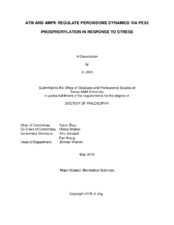| dc.description.abstract | Peroxisomes are single membrane-bound and autonomously replicating subcellular organelles. While their function as metabolic organelles is well known, their place in the world of cell signaling is only just beginning to emerge.
Peroxisomes are able to adjust their number in response to changing environmental and/or physiological conditions. It is crucial to maintain peroxisome homeostasis for normal cellular functions. High risk pathologies are associated with too few peroxisomes, such as peroxisome biogenesis disorders (PBDs), and too many peroxisomes, such as disorders that increase cellular ROS production to promote the development of disease, including cancer. Early studies have shown that pexophagy (selective autophagy of peroxisomes) is responsible for the decrease in superfluous or damaged peroxisomes, yet the mechanisms of initiation of pexophagy are not well defined, especially in mammalian cells. In Chapter II of this dissertation, we report a key role for the ataxia-telangiectasia mutated (ATM) kinase at the peroxisomes as a sensor of ROS that regulates pexophagy. ATM is recognized and localized to the peroxisome by PEX5. In response to ROS, ATM signaling activates ULK1 and suppresses mTORC1 to induce pexophagy. Concomitant with activation of ULK1, ATM phosphorylates PEX5 at Serine 141. This modification then promotes PEX5 mono-ubiquitination at Lysine 209. Mono-ubiquitinated PEX5 is
iii
sufficient to target peroxisomes to the autophagosome via ubiquitin adaptor protein p62, leading to the initiation of pexophagy.
Peroxisomes do not contain DNA, hence all their proteins are encoded inside the nucleus, synthesized by free polyribosomes in the cytoplasm and delivered to peroxisome with the help of import receptors. It is known that PEX5 recognizes the peroxisome targeting sequence 1 (PTS1) of peroxisomal proteins and delivers them to peroxisome. However, how cells control this delivery has remained a mystery. In Chapter III of this dissertation, we found that AMP-activated protein kinase (AMPK) phosphorylates PEX5 at Ser279, which correlates with the import of peroxisomal proteins in response to low energy.
Thus, we have uncovered a previously unappreciated link between the peroxisome and the ATM and AMPK signaling pathways, which paves the way for a deeper understanding of peroxisome dynamics and its role in cellular metabolism. | en |


